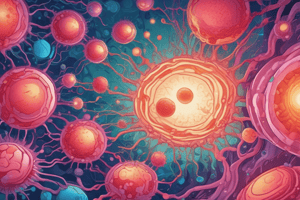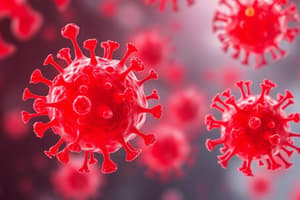Podcast
Questions and Answers
What is the primary leukocyte type recruited during the initial phase of a bacterial infection?
What is the primary leukocyte type recruited during the initial phase of a bacterial infection?
- Lymphocytes
- Monocytes
- Neutrophils (correct)
- Eosinophils
Which adhesion molecule is primarily responsible for mediating the rolling of leukocytes along the endothelium?
Which adhesion molecule is primarily responsible for mediating the rolling of leukocytes along the endothelium?
- Integrins
- Selectins (correct)
- Cytokines
- Chemokines
What is the fate of neutrophils after their emigration to the site of inflammation?
What is the fate of neutrophils after their emigration to the site of inflammation?
- They transform into macrophages
- They migrate back to the bloodstream
- They undergo apoptosis after 24 to 48 hours (correct)
- They multiply indefinitely
Which type of leukocytes replace neutrophils during the second phase of necrosis after 24 to 48 hours?
Which type of leukocytes replace neutrophils during the second phase of necrosis after 24 to 48 hours?
What triggers the enhanced expression of adhesion molecules on leukocytes and endothelium during inflammation?
What triggers the enhanced expression of adhesion molecules on leukocytes and endothelium during inflammation?
Which mechanism primarily drives leukocyte movement through the endothelium?
Which mechanism primarily drives leukocyte movement through the endothelium?
What role do chemokines play in leukocyte movement?
What role do chemokines play in leukocyte movement?
What is the first step in the process of phagocytosis by leukocytes?
What is the first step in the process of phagocytosis by leukocytes?
Which of the following is NOT considered a chemotactic agent?
Which of the following is NOT considered a chemotactic agent?
How do leukocytes exert force to move in response to chemotactic agents?
How do leukocytes exert force to move in response to chemotactic agents?
What is the primary function of reactive oxygen species (ROS) in the phagolysosome?
What is the primary function of reactive oxygen species (ROS) in the phagolysosome?
Which enzyme is responsible for converting hydrogen peroxide into hypochlorite in neutrophils?
Which enzyme is responsible for converting hydrogen peroxide into hypochlorite in neutrophils?
What role do cytokines play in the activation of macrophages?
What role do cytokines play in the activation of macrophages?
Which of the following is NOT a function of activated leukocytes?
Which of the following is NOT a function of activated leukocytes?
What characteristic makes neutrophils the predominant leukocyte in acute inflammation during the initial hours?
What characteristic makes neutrophils the predominant leukocyte in acute inflammation during the initial hours?
What happens to neutrophils after they have completed their function in the tissues?
What happens to neutrophils after they have completed their function in the tissues?
In prolonged inflammatory reactions, which cell type becomes the dominant population?
In prolonged inflammatory reactions, which cell type becomes the dominant population?
What is the main function of lysosomal enzymes released into the phagolysosome?
What is the main function of lysosomal enzymes released into the phagolysosome?
What type of reactive nitrogen species is produced by inducible nitric oxide synthase (iNOS)?
What type of reactive nitrogen species is produced by inducible nitric oxide synthase (iNOS)?
How do activated leukocytes influence inflammatory reactions?
How do activated leukocytes influence inflammatory reactions?
Flashcards
Leukocyte Recruitment
Leukocyte Recruitment
The process by which white blood cells move from the bloodstream into tissue, commonly during inflammation.
Selectins
Selectins
Molecules that bind to specific receptors on leukocytes and endothelium, initiating rolling and weak adhesion during leukocyte recruitment.
Integrins
Integrins
Molecules that mediate firm adhesion between leukocytes and endothelium, further promoting leukocyte recruitment.
Cytokines Role in Leukocyte Recruitment
Cytokines Role in Leukocyte Recruitment
Signup and view all the flashcards
Chemotaxis
Chemotaxis
Signup and view all the flashcards
Leukocyte Transmigration
Leukocyte Transmigration
Signup and view all the flashcards
Opsonins
Opsonins
Signup and view all the flashcards
Phagocytosis
Phagocytosis
Signup and view all the flashcards
Phagocytic Receptors
Phagocytic Receptors
Signup and view all the flashcards
Phagosome
Phagosome
Signup and view all the flashcards
Phagolysosome
Phagolysosome
Signup and view all the flashcards
Reactive Oxygen Species (ROS)
Reactive Oxygen Species (ROS)
Signup and view all the flashcards
Granules
Granules
Signup and view all the flashcards
Myeloperoxidase (MPO)
Myeloperoxidase (MPO)
Signup and view all the flashcards
Lysozyme
Lysozyme
Signup and view all the flashcards
Inducible Nitric Oxide Synthase (iNOS)
Inducible Nitric Oxide Synthase (iNOS)
Signup and view all the flashcards
Peroxynitrite
Peroxynitrite
Signup and view all the flashcards
Neutrophils
Neutrophils
Signup and view all the flashcards
Study Notes
Acute Inflammation Pathogenesis
- Learning Objectives: Students will be able to evaluate leukocyte recruitment, understand the role of neutrophils and macrophages, classify acute inflammation types, and correlate subtypes with clinical conditions.
Leukocyte Recruitment
- Neutrophils and macrophages are recruited to sites of injury to eliminate pathogens and debris, initiating tissue repair.
- The type of leukocyte recruited depends on the initial stimulus and duration of the inflammatory response.
- Bacterial infections primarily recruit neutrophils.
- Viral infections recruit lymphocytes.
- Allergic reactions increase eosinophils.
- Necrosis initially induces neutrophilic recruitment, transitioning to monocytes after 24-48 hours.
Leukocyte Migration
- Leukocytes move from blood vessels to tissue interstitium through a multi-step process:
- Margination, rolling, and adhesion to endothelium.
- Transmigration across the endothelium.
- Migration towards chemoattractants (chemotaxis).
- Apoptosis (programmed cell death) occurs in neutrophils after 24-48 hours, whereas monocytes survive longer.
Leukocyte Adhesion & Interactions
- Leukocyte movement involves adhesion molecules on both leukocytes and endothelium.
- Key adhesion molecule pairs include selectins (initiating weak interactions) and integrins (mediating firm adhesion).
- Cytokines (e.g., TNF, IL-1) enhance adhesion molecule expression.
Leukocyte Transmigration
- Leukocytes migrate through the vessel wall by squeezing between endothelial cells at intercellular junctions.
- They cross the basement membrane and enter the extravascular tissue, without significant vessel wall injury.
Chemotaxis
- Chemotaxis is directional cell movement along a chemical gradient.
- Chemotactic agents (e.g., bacterial products, complement components, chemokines) attract leukocytes to the site of injury.
- Leukocyte movement is facilitated by actin polymerization and interaction with the extracellular matrix.
Phagocytosis
- Phagocytosis is the process of engulfing and destroying pathogens or cellular debris.
- Phagocytes recognize and attach to targets via phagocytic receptors.
- Internalization of the target forms a phagosome, which fuses with lysosomes to form phagolysosomes.
- Reactive oxygen species (ROS), reactive nitrogen species, and lysosomal enzymes degrade the target material within the phagolysosome.
Role of Neutrophils and Macrophages
- Neutrophils and macrophages are crucial in pathogen clearance and tissue damage repair.
- These cells contain granules with antimicrobial enzymes and proteins.
ROS & other Products
- Reactive oxidative species (ROS) are potent antimicrobial products.
- Activated leukocytes, particularly macrophages, produce cytokines regulating inflammatory reactions and growth factors promoting collagen synthesis.
Termination of Acute Inflammation
- Mediators have short half-lives and stop signals (anti-inflammatory cytokines, e.g., TGF-β, IL-10) regulate the inflammatory response.
Morphologic Hallmarks
- Vasodilation of small blood vessels.
- Fluid and leukocyte accumulation in extravascular tissue.
Serous Inflammation
- Fluid exudation in body cavities lining or surface epithelium.
- This fluid is mostly protein-poor, sterile with little leukocyte accumulation (not typically infected).
- Examples include skin blisters due to burns or infections.
Fibrinous Inflammation
- Procoagulant stimulus or increased vascular permeability causing higher-molecular-weight proteins like fibrinogen to leak out from the blood, forming fibrin deposits in the extracellular space.
- Examples include linings of body cavities, meninges, pericardium, and pleura.
- Fibrin may be removed by lysis or cleared by macrophages, ultimately leading to scarring.
Purulent(Suppurative) Inflammation
- Characterized by pus formation (neutrophils, liquefied necrotic debris, and edema fluid).
- Usually caused by bacterial infections with pyogenic (pus-forming) bacteria.
- Examples include abscesses and some ulcers.
Studying That Suits You
Use AI to generate personalized quizzes and flashcards to suit your learning preferences.




